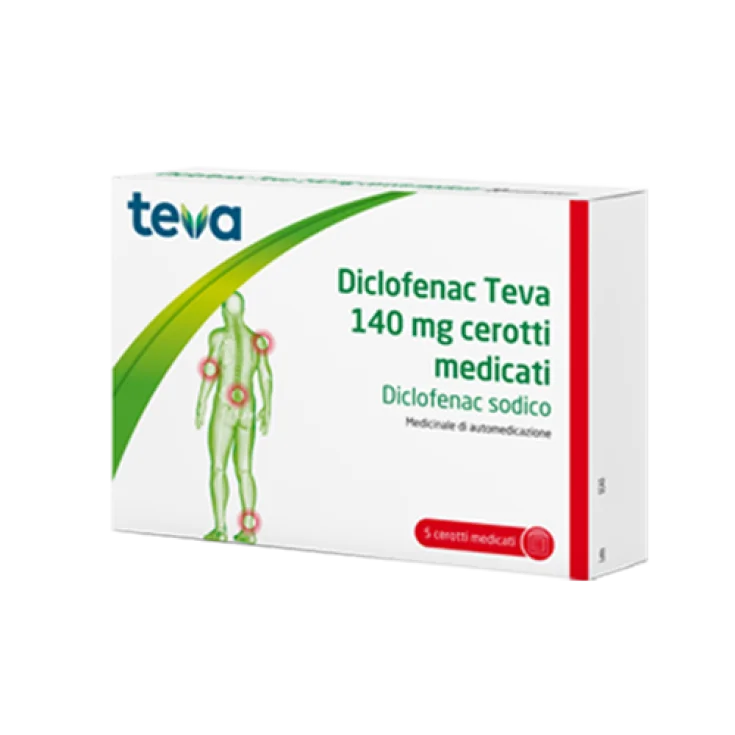DICLOFENAC TE*5CER MED 140MG
- Brand: TEVA B.V.
- Product Code: 038721015
- EAN:
- Availability: In Stock (evaso in 24 ore)
- 3 items
for 10,36€ each - 4 items
for 10,15€ each - 5 items
for 9,94€ each
What it is and what it is used for
Diclofenac Teva is a medicine that reduces pain. It belongs to the group of non-steroidal anti-inflammatory drugs (NSAIDs).
Diclofenac Teva is used in short-term treatments for the symptomatic local relief of acute pain associated with muscle strains, sprains or bruises of the arms and legs resulting from non-penetrating trauma.
For cutaneous use only.
What you need to know before taking the medicine
Do not use Diclofenac Teva
- If you are allergic to diclofenac, propylene glycol, butylated hydroxytoluene or any of the other ingredients of this medicine (listed in section 6).
- If you are allergic to any other non-steroidal anti-inflammatory drugs (NSAIDs, e.g. acetylsalicylic acid, ibuprofen).
- If you have experienced asthma, swelling of the skin or swelling and irritation inside the nose after taking acetylsalicylic acid or other NSAIDs.
- If you suffer from active peptic ulcer.
- On damaged skin (e.g. skin abrasions, cuts, burns), infected or with eczema.
- During the last three months of pregnancy.
Warnings and precautions
Talk to your doctor or pharmacist before taking Diclofenac Teva
- If you suffer or have suffered in the past from bronchial asthma or allergies, you may experience a cramp in the bronchi (bronchospasm), which manifests itself with difficulty in breathing.
- If a skin rash appears; remove the medicated plaster immediately and stop treatment.
- If you suffer from kidney, heart or liver dysfunction or suffer or have suffered in the past from gastrointestinal ulcer, intestinal inflammation or bleeding tendency.
Side effects can be minimized by using the lowest effective dose for the shortest possible treatment duration.
IMPORTANT precautions:
- If symptoms persist for more than 3 days you should contact your doctor.
- Do not use the medicated plaster on the eyes or mucous membranes and avoid contact with these parts.
- The product should only be applied to intact, healthy skin and should not be kept on when bathing or showering.
Avoid exposing the treated area to direct sunlight or sunlamps for about a day after removing Diclofenac Teva, to reduce the risk of light sensitization.
Do not use other medicines containing diclofenac or other NSAIDs at the same time, either topically or systemically.
Possible side effects
Like all medicines, this medicine can cause side effects, although not everybody gets them.
If the following symptoms appear, tell your doctor immediately and stop using the patch:
sudden itchy skin rash (hives); swelling of the hands, feet, ankles, face, lips, mouth, or throat; difficulty breathing; low blood pressure or weakness.
The following side effects may occur:
Common (may affect up to 1 in 100 people): application site reactions, rash, eczema, redness of the skin, dermatitis (including allergic dermatitis and contact dermatitis), swelling of the skin, itching and burning sensations.
Uncommon (may affect up to 1 in 1000 people): generalized skin rash, hypersensitivity reactions (including urticaria), swelling of the mucous membranes, generalized excessive allergic reaction.
Rare (may affect up to 1 in 10,000 people): bullous dermatitis, dry skin.
Very rare (may affect less than 1 in 10,000 people): asthma attack, severe eczema, pustular rash, ulcerative skin rash, photosensitivity reaction.
Frequency not known (frequency cannot be estimated from the available data): hematoma at the application site.
The absorption of diclofenac into the body through the skin is very low and the concentration of diclofenac in the blood is also very low compared to the concentration of the active ingredient in the blood after oral intake. Therefore, the probability of the appearance of systemic side effects (such as gastrointestinal, hepatic or renal disorders, bronchospasm) is very low after topical application compared to the frequency of side effects associated with the oral use of diclofenac. However, if diclofenac is used on large skin surfaces and for long periods of time, the appearance of systemic side effects is possible.
Reporting of side effects
If you get any side effects, talk to your doctor or pharmacist, including any not listed in this leaflet. You can also report side effects directly via the national reporting system at: https://www.aifa.gov.it/content/segnalazionireazioni-avverse .
By reporting side effects you can help provide more information on the safety of this medicine.






